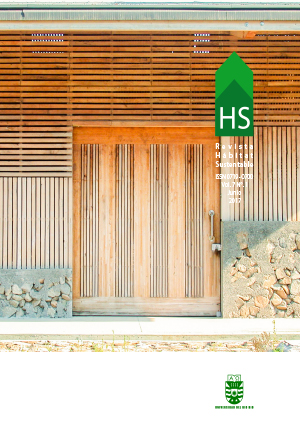Influencia del uso y gestión de la envolvente en el comportamiento térmico de verano de una vivienda en la ciudad de Mendoza, Argentina
DOI:
https://doi.org/10.22320/07190700.2017.07.02.06Palabras clave:
USO Y GESTIÓN, uso y gestión, CONFORT TÉRMICO, confort térmico, VENTILACIÓN NOCTURNA., ventilación nocturnaResumen
En la ciudad de Mendoza, Argentina, las viviendas presentan mayoritariamente una baja calidad constructiva en relación con la falta de aislamiento de sus envolventes. Se estima que el 95% de las viviendas existentes no están aisladas en su envolvente vertical y presentan aislamiento insuficiente en techos. En un clima templado continental, con grandes amplitudes térmicas diarias y estacionales, las viviendas presentan inercia térmica como única estrategia bioclimática. En estas circunstancias, las posibilidades de gestión que ofrezca la envolvente -a través de elementos practicables y/o móviles-, son claves para la aproximación al logro del confort interior. El presente trabajo analiza la influencia del uso y gestión de las aberturas en la envolvente a cargo del usuario en una vivienda tradicional, mediante monitoreo higrotérmico, durante 59 días en verano. Para ello, se midieron dos períodos con distintas condiciones climáticas (extremas y moderadas) en los que se aplicó la estrategia de ventilación natural nocturna, gracias a la cual se obtuvo 82% de horas en confort. Asimismo, se midió un período sin gestión de las aberturas en la envolvente, es decir, manteniéndolas cerradas; de lo que resultó solo un 6% de horas en confort. Se concluye, en suma, que la intervención comprometida y consciente del usuario mediante el aprovechamiento de la ventilación nocturna, en combinación con la inercia térmica del envolvente, desempeña un papel importante en el logro de condiciones térmicas en interiores que reducen el sobrecalentamiento durante el verano.
Descargas
Citas
AMERICAN SOCIETY OF HEATING, REFRIGERATING AND AIR-CONDITIONING ENGINEERS, INC. ASHRAE. Proposed addendum d to Standard 55-2004, Thermal environmental conditions for human occupancy. Atlanta GA, 2008.
ANDREONI TRENTACOSTE., Soledad E. Protocolo de diagnóstico térmico - energético para la rehabilitación de viviendas en la Ciudad de Mendoza, Argentina.[En linea]. Tesis de Maestría. Universidad Internacional de Andalucía, España, 2014. Disponible en: http://hdl.handle.net/10334/3781
FLORES LARSEN, Silvana, FILIPPÍN, Celina y LESINO, Graciela. La incidencia de los usuarios en el comportamiento termico de verano de una vivienda en el noroeste argentino. Documento presentado en: IV Conferencia Latino Americana de Energía Solar (IV ISES_CLA) y XVII Simposio Peruano de Energía Solar (XVII- SPES), Cusco, Perú. 1-5 de Noviembre,2010.
GANEM, Carolina. Rehabilitación ambiental de la envolvente de viviendas. El caso de Mendoza. Tesis Doctoral. Universidad Politécnica de Cataluña, España, 2006.
GIVONI, Baruch y VECCHIA, Francisco. Predicting thermal performance of occupied houses. Proceedings of the PLEA. November, 2001.
INVIDIATA, Andrea y GHISI, Enedir. Impact of climate change on heating and cooling energy demand in houses in Brazil. Energy and Buildings [en linea], 2016, n°130, pp.20-32. DOI: 10.1016/j.enbuild.2016.07.067.
NICOL, Fergus. Adaptive thermal comfort in domestic buildings. Documento presentado en: Making Comfort Relevant: 9th Windsor 2016. Cumberland Lodge, Windsor, UK. 2016.
OLGYAY, Victor. Arquitectura y clima. Manual de arquitectura bioclimática para arquitectos. Barcelona, España. Ed. Gustavo Gili, 1998.
PALME, Massimo, CARRASCO, Claudio y GALVEZ, Miguel Ángel. Estimación del riesgo de sobrecalentamiento y del potencial de refrigeración por ventilación natural de viviendas unifamiliares en ciudades costeras de Chile. Habitat Sustentable, 2016. Vol. 6, p. 52–61.
Descargas
Publicado
Cómo citar
Número
Sección
Licencia
El contenido de los artículos que se publican en cada número de Hábitat Sustentable, es responsabilidad exclusiva de los autores y no representan necesariamente el pensamiento ni comprometen la opinión de la Universidad del Bío-Bío.
Los autores/as conservarán sus derechos de autor y garantizarán a la revista el derecho de primera publicación de su obra, el cuál estará simultáneamente sujeto a la Licencia de Reconocimiento de Creative Commons CC BY-SA que permite a otros compartir-copiar, transformar o crear nuevo material a partir de esta obra con fines no comerciales, siempre y cuando se reconozcan la autoría y la primera publicación en esta revista, y sus nuevas creaciones estén bajo una licencia con los mismos términos.











 Programa de Información Científica/Concurso Fondos de Publicación de Revistas Científicas 2018/ Proyecto Mejoramiento de Visibilidad de Revistas UBB (Código:FP180007)
Programa de Información Científica/Concurso Fondos de Publicación de Revistas Científicas 2018/ Proyecto Mejoramiento de Visibilidad de Revistas UBB (Código:FP180007) 





